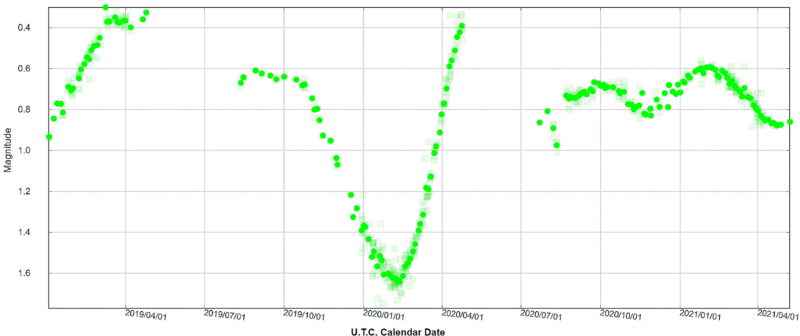Betelgeuse’s 2021 April minimum agrees with prediction of 430-day period
2021 July 31
Interest in Betelgeuse remains high. No fewer than 6,089 visual estimates of the star have been submitted to the American Association of Variable Star Observers (AAVSO) database since the start of 2019 – 3,889 for the 2019/’20 observing season and 1,735 for 2020/21, compared to an average of 780 for the ten years prior to 2019 and an average of 320 per year over the full 125 years of light-curve coverage. After the deep minimum of Betelgeuse in 2020, there was a speculative suggestion that a new minimum of approximately magnitude +1.0 should occur around 2021 Apr 12, with a possible error of around ±10 days.
One of the big advances in variable star observing is the increased number of observers who can carry out high-accuracy photoelectric photometry. These data show that after the brief fade observed by the STEREO satellite down to magnitude +1.0 in 2020 mid-August, the magnitude oscillated over a small range from +0.60 to +0.82 between the late part of that month and early 2021. A systematic fade started in mid-February, with a rate of 0.026 magnitudes per week, reaching a flat minimum of +0.88 around Apr 23. The very scarce data after this suggest that a recovery has started. Both the photoelectric photometry (Figure 1) and three-day means of the visual estimates (Figure 2) show the minimum.


It might be surprising that visual observers detected this small minimum: a range of 0.3 magnitudes is generally thought to be below the level of visual detectability. The raw light curve is extremely noisy: in early April of 2021, when the average magnitude was +0.8, there were estimates reported as faint as +1.5 and as bright as +0.1! When we take three-day means of the visual estimates (Figure 2), the fade in early 2021 is obvious and even the small November dip seen in the photoelectric data seems to be present. This is an example of the well-known ‘gobstopper theorem’, whereby if a large enough number of people estimate the number of sweets (or gobstoppers) in a jar, then while the individual estimates will show large variation, the mean of the estimates will be surprisingly close to the true number.
There have been many new studies of Betelgeuse inspired by its recent activity. One, using nine years of photometry from the Coriolis satellite to supplement ground-based photometry and the AAVSO archive, shows an average pulsation period of 416±24d and a long secondary period of 2,365±10d (6.48 years), neither of which are strictly periodic. Underneath them, there is a further pulsation period of 185.5±0.1d in the modern, photometric data. Deep minima in the light curve such as that of 2020 require other causes, such as dimming by dust clouds, but they may show a 35–40-year period, similar to the estimated rotation period of 35 years.
By combining data sets with multiple simulations of evolution and oscillations, the study concludes that the distance to Betelgeuse is 548 light-years, with uncertainty giving a possible range of 499–634 light-years; this is similar to the ‘traditional’ value for the distance and smaller than recent determinations from radio data. The pulsation periods in the light curve suggest that the mass of the star is 16.9–19 solar masses and that it is early in the helium-burning phase, rather than half-way through or late in it, as has been assumed previously. Betelgeuse is heading for a death as a type IIp supernova, but maybe not for another half a million years.
Other studies conclude that the fast rotation of Betelgeuse (15km/s), giving a rotation period of 31±8 years, is extremely difficult to account for by standard stellar evolution models. The star has probably, in the last million or so years, swallowed a 1–4-solar-mass binary companion.
Mark Kidger, ESA/ESAC
The Variable Star Section Director notes that a paper by Dr Kidger in the 2020 December Journal [130(6), 342–348 (2020)] described the long-term light curve of Betelgeuse and included his suggestion of a new minimum around 2021 April. BAA members are encouraged to continue to observe the star when it appears from solar conjunction, and to contribute their observations to the Section.
| The British Astronomical Association supports amateur astronomers around the UK and the rest of the world. Find out more about the BAA or join us. |
